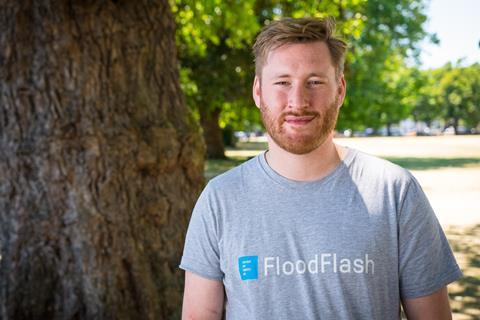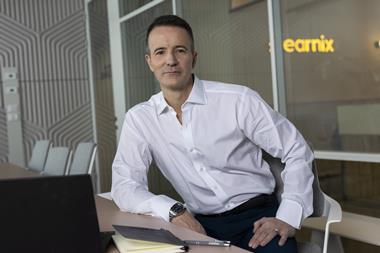FloodFlash’s co-founder Adam Rimmer tells Insurance Times why re-educating brokers is a challenge if the parametric model is going to be applied to business interruption insurance, but nonetheless it is a positive move. The insurtech is a finalist in both the Claims Excellence Awards and the Technology & Innovation Awards 2020
Re-educating brokers is a key challenge if a parametric model is going to be applied to business interruption insurance for SMEs.
According to insurtech MGA FloodFlash’s co-founder, Adam Rimmer, the longer a broker has worked in the insurance industry, the more difficult it is for them to grasp new concepts or adapt to changes.
Rimmer said the change in model for this type of insurance could still be a paradigm shift for brokers, “it is revolution rather than evolution.”
The insurtech and Lloyd’s coverholder encountered the same obstacle with flood insurance, and published several videos and relevant information on its website to overcome this issue.
Speaking about applying the parametric model to business interruption cover, Rimmer told Insurance Times: “It has to be a market solution at this stage.”

The house is already on fire
“Parametric would always be difficult to do for a second wave of Covid-19 because we are not going from a standing start – ‘the house is already on fire,’ so whether or not there can be a private market solution to a second wave will be real challenge. [But] if anything can do it, parametric insurance can,” he said.
Machine Cover launched a parametric insurance product for business interruption in July linked to economic activity.
In terms of applying the same thinking around parametric flood insurance to business interruption, Rimmer said that pre-Covid-19 FloodFlash was helping brokers to understand flood insurance by going around to offices and offering training programmes, however in a pandemic world this has changed.
He said that this method of re-educating brokers was something that the insurtech learnt early on in the days of FloodFlash. It wasn’t just about telling brokers about parametric insurance, instead brokers needed to be an effective distribution channel and know the product well enough to be able to speak to their clients about it – which required a different level of understanding.
“This is the responsibility of our Broker Success Team,” Rimmer said. ”Back in the real world they were going round to broker retail offices all around the UK, now it is a bit more Zoom-based. But they do a great job at that.
“I think generally brokers are keen to have a differentiated product that they can share with their clients. It just takes a bit of time and education for them.”
No such thing as bad risk
Rimmer previously worked at risk modelling firm RMS for nearly six years, working on triggers for big reinsurance contracts and spotted that flooding cover was a problem worldwide.
“What inspired FloodFlash was a product we put together for the New York Subway after Hurricane Sandy [in 2012],” he said. Hurricane Sandy was a tropical storm that hit New York, causing extensive flooding damage.
Using this product, flood cover was able to be given in this instance. The two co-founders, Rimmer and Ian Bartholomew, who both worked at RMS at the time debated the idea travelling home from work on the Northern Line, and decided to apply this concept to flood insurance for SMEs. FloodFlash was set up in Bartholomew’s kitchen, back in 2016.
“There is no other parametric flood insurance [for SMEs] available in the UK, the speed of pay out that parametric insurance gives us versus the speed of a traditional policy increases the chances of that business surviving that catastrophe and therefore makes the insurance useful,” Rimmer said.

The biggest challenge for flood insurance is that many insurers do not want to cover it. but Rimmer contests this arguing “there is no such thing as bad risk, just bad pricing”.
Flood insurance in the UK is typically not sold as a standalone cover, very few insurers sell it in this manner. Instead flood insurance is included as a default in property cover, however those in a high-risk flooding area may fall short as the insurer could refuse to cover it or apply a higher premium. Although, in international markets flood insurance is always sold separately, he explained.
Rimmer, has recently launched FloodFlash plus, which opens its products up to bigger companies and more complex risk, and it is continuing to work with UK brokers.
Reinsurance
FloodFlash is a finalist in both Insurance Times’s virtual Technology & Innovation Awards in September and the Claims Excellence Awards in October.
Speaking about FloodFlash’s entry in the Claims Excellence Awards 2020, Rimmer said the idea for the insurtechs entry came about as the concept already exists in the world of reinsurance. FloodFlash is a finalist in two categories – the first is Claims Start Up where it is up against Claim Technology, Pact Global and Xtract.
In Claims Product Solution of the Year – Insurtech, it is up against Smart Cover and Claim Technology.
When asked about the leverage that winning an award might give FloodFlash, Rimmer said: “It would help tell that story that everyone needs to know, [which is] as an industry we will save more businesses [and] keep livelihoods going if we are able to move to this new paradigm. The storms in February and Covid-19 has proved that, and it would be a great outcome.”
As a finalist in the Technology & Innovation Awards the insurtech is competing in the category for the Best use of Technology for Customer Experience – Claims (General) it is up against the likes of Home & Legacy and Zurich.
Meanwhile it has been also selected as a finalist for Insurance Start-up B2B where it is up against Arbitrate, Balkerne and Pact Global.
Read more…How parametric insurance could serve SMEs in a post pandemic world
Not subscribed? Become a subscriber and access our premium content














































No comments yet